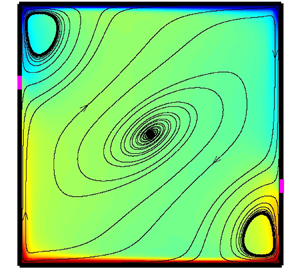Article contents
Stabilizing/destabilizing the large-scale circulation in turbulent Rayleigh–Bénard convection with sidewall temperature control
Published online by Cambridge University Press: 09 March 2021
Abstract

In this paper, we designed two different configurations with locally isothermal sidewalls, where the temperature is set to be the bulk temperature, to control the large-scale circulation in turbulent Rayleigh–Bénard convection, namely two-point control and four-point control. At fixed Rayleigh number  $Ra=10^8$ and Prandtl number
$Ra=10^8$ and Prandtl number  $Pr=2$, a series of direct numerical simulations are performed on both two-dimensional (2-D) and quasi-two-dimensional (quasi-2-D) cavities with both types of control, where the width of the control area is fixed at
$Pr=2$, a series of direct numerical simulations are performed on both two-dimensional (2-D) and quasi-two-dimensional (quasi-2-D) cavities with both types of control, where the width of the control area is fixed at  $\delta _c=0.05$ and the vertical distance from the cavity centre
$\delta _c=0.05$ and the vertical distance from the cavity centre  $h_c$ varies from 0 to 0.45 with an interval of 0.05. Our results show that the control effect depends on
$h_c$ varies from 0 to 0.45 with an interval of 0.05. Our results show that the control effect depends on  $h_c$, the control configurations as well as the flow dimensions. For 2-D cavities, both two-point control and four-point control suppress the flow reversal when
$h_c$, the control configurations as well as the flow dimensions. For 2-D cavities, both two-point control and four-point control suppress the flow reversal when  $h_c \geq 0.05$, accompanied by the enhancement of vertical heat transfer and the strength of the large-scale circulation. For quasi-2-D cavities, the suppression of the flow reversals is obvious with two-point control and
$h_c \geq 0.05$, accompanied by the enhancement of vertical heat transfer and the strength of the large-scale circulation. For quasi-2-D cavities, the suppression of the flow reversals is obvious with two-point control and  $h_c\geq 0.05$, while the effect is rather limited with four-point control. Further experiments with
$h_c\geq 0.05$, while the effect is rather limited with four-point control. Further experiments with  $Pr=5.7$ and
$Pr=5.7$ and  $Ra$ up to
$Ra$ up to  $7.36\times10^8$ show that two-point control with
$7.36\times10^8$ show that two-point control with  $h_c=0.15$ can effectively suppress the flow reversal, while two-point control with
$h_c=0.15$ can effectively suppress the flow reversal, while two-point control with  $h_c=0$ can suppress the reversals at low
$h_c=0$ can suppress the reversals at low  $Ra=1.93\times 10^8$ and activate them at higher
$Ra=1.93\times 10^8$ and activate them at higher  $Ra=7.36\times 10^8$, which agrees well with our numerical simulations.
$Ra=7.36\times 10^8$, which agrees well with our numerical simulations.
- Type
- JFM Papers
- Information
- Copyright
- © The Author(s), 2021. Published by Cambridge University Press
References
REFERENCES
- 13
- Cited by





